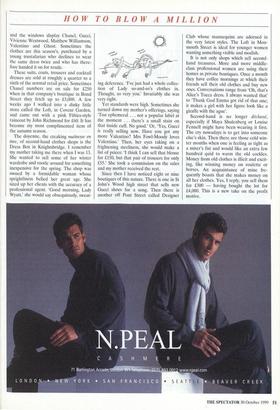HAVING SECOND THOUGHTS
Petronella Wyatt charts the rise of the 'designer sale' boutiques
THERE comes a time in every woman's life when she finds herself staring into the window of a second-hand dress shop. It is a defining moment, like reading one's first Proust, receiving one's first kiss and then one's first kiss-off. 'Second-hand Rose, they call me,' sang Barbra Streisand. Oh, but in those days it was kept in the family. Suddenly, second-hand dress shops are becoming one of the largest growth indus- tries in Britain. It is well nigh impossible to amble down a reasonably sized metropoli- tan high street without running into a sign bearing the words 'Designer Sale Shop' or `Couture for Less'. And less is more. The metropolis is, as Mary Crawford remarked, a fair sample of the whole.
The late but not tardy Jacqueline Onas- sis was one of the first women to suss the financial opportunities (credit side) implic- it in hand-me-on clothes. She bought using her husband's money, of course numerous couture pieces from Paris and Milan and then sold them on, having worn them once or even not at all. In this way Mrs 0. was never short of pocket moolah.
But most second-hand dress shops have not enjoyed a very glamorous reputation. Received wisdom has it that one is less likely to find Missoni and Saint-Laurent than Marks and Spencer, while the tawdry interiors and rusty rails are about as invit- ing as a 19th-century pissoir.
Once upon a time this may have been the case. There used to be a depressing shop near my home in north London run by two thin ladies. They smelt disgustingly of incense and creosote, like nuns. If one were lucky one might rummage around for a few hours and come out with a grime- encrusted Dior belt, but the rest of the stuff was strictly thrift-store fashion, for distressed gentlewomen only.
No longer. As we approach the millenni- um these establishments are owned by bright young things in Dolce and Gabbana 'That's the quickest I've ever seen a woman let herself go.' and the windows display Chanel, Gucci, Vivienne Westwood, Matthew Williamson, Valentino and Ghost. Sometimes the clothes are this season's, purchased by a young trustafarian who declines to wear the same dress twice and who has there- fore handed it on for resale.
These suits, coats, trousers and cocktail dresses are sold at roughly a quarter to a sixth of the normal retail price. Sometimes Chanel numbers are on sale for £250 when in that company's boutique in Bond Street they fetch up to £3,000. A few weeks ago I walked into a dinky little store called the Loft, in Covent Garden, and came out with a pink Fifties-style raincoat by John Richmond for £60. It has become my most complimented item of the autumn season.
The doyenne, the creaking maftresse en titre, of second-hand clothes shops is the Dress Box in Knightsbridge. I remember my mother taking me there when I was 13. She wanted to sell some of her winter wardrobe and rootle around for something inexpensive for the spring. The shop was owned by a formidable woman whose sprightliness belied her great age. She sized up her clients with the accuracy of a professional agent. 'Good morning, Lady Wyatt,' she would say obsequiously, sweat-
ing deference. 'I've just had a whole collec- tion of Lady so-and-so's clothes in. Thought, so very you.' Invariably she was very right.
Yet standards were high. Sometimes she turned down my mother's offerings, saying 'Too ephemeral ... not a popular label at the moment ... there's a small stain on that inside cuff. No good.' Or, 'Yes, Gucci is really selling now. Have you got any more Valentino? Mrs Fowl-Moody loves Valentino.' Then, her eyes taking on a frightening steeliness, she would make a list of prices: 'I think I can sell that blouse for £150, but that pair of trousers for only £55.' She took a commission on the sales and my mother received the rest.
Since then I have noticed eight or nine boutiques of this nature. There is one in St John's Wood high street that sells new Gucci shoes for a song. Then there is another off Pont Street called Designer Club whose mannequins are adorned in the very latest styles. The Loft in Mon- mouth Street is ideal for younger women wanting something visible and modish.
It is not only shops which sell second- hand treasures. More and more middle- class professional women are using their homes as private boutiques. Once a month they have coffee mornings at which their friends sell their old clothes and buy new ones. Conversations range from 'Oh, that's Alice's Tocca dress. I always wanted that' to 'Thank God Emma got rid of that one; it makes a girl with her figure look like a giraffe with the ague'.
Second-hand is no longer déclassé, especially if Maya Shulenberg or Louise Fennell might have been wearing it first. The cry nowadays is to get into someone else's skin. Then there are those cold win- ter months when one is feeling as tight as a miser's fist and would like an extra few hundred quid to warm the old cockles. Money from old clothes is illicit and excit- ing, like winning money on roulette or horses. An acquaintance of mine fre- quently boasts that she makes money on all her clothes. Yes, I reply, you sell them for £300 — having bought the lot for £4,000. This is a new take on the profit motive.



























































































 Previous page
Previous page